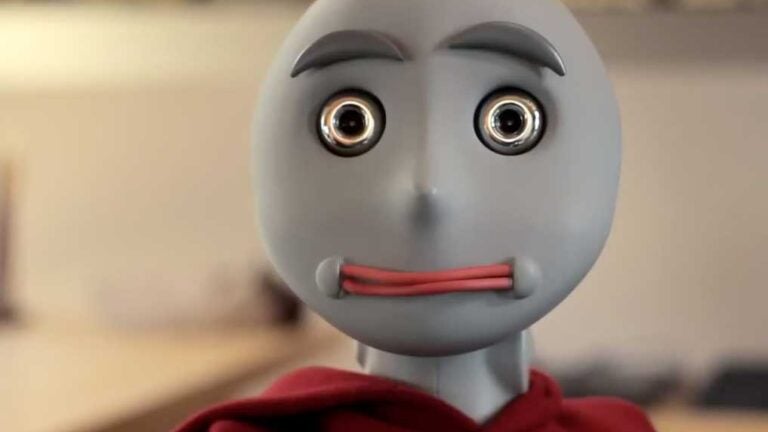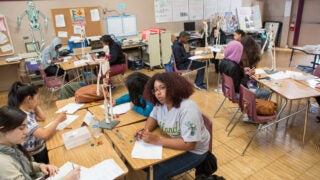
Bandit is a social robot that can help humans improve their lives. (Photo/Courtesy of USC Viterbi)
A future with robots as companions could be closer than you think
A USC professor studies how robots can assist emotional, physical and social rehabilitation. Will the next two decades see them become the best managers of our well-being?
https://www.youtube.com/watch?v=NneIdd4WEUs
The 2012 movie Robot & Frank described a “near future” that would allow us to spend our golden years living “co-dependently independently,” fulfilled by ever-present robot companions that could watch out for loss of balance and falls, prompt us to do constructive home projects like gardening and even become something like our best friends.
That future might be nearer than we think.
At least that’s the vision of USC Professor Maja Matarić. After more than a decade and a half of testing and researching the positive effects socially assistive robots can have on vulnerable populations, Matarić is looking at how she can help speed this technological march into our living rooms and care facilities.
As the first step in that march, the USC Viterbi School of Engineering vice dean of research and USC Interaction Lab director co-founded the Pasadena company Embodied Inc., which is working on developing and bringing affordable socially assistive robots to market. The first “Embodied robot” for consumers will begin its testing within the year.
I want to take the robots out of the lab.
Maja Matarić
“I want to take the robots out of the lab,” said Matarić, a professor of computer science, neuroscience and pediatrics at the USC Viterbi School of Engineering. “This is especially important to me because the users I am focusing on have special needs and the sooner we can help them, the better.”
Matarić’s research robots have already motivated and brightened the days of patients in the cardiac ward of Los Angeles County + USC Medical Center, the autism clinic at Children’s Hospital Los Angeles and the Alzheimer’s care unit at Silverado Senior Living, as well as special education and public elementary schools and Be Group retirement homes.
The personal robot revolution
As Steve Jobs once said that the personal computer was a bicycle for the mind, it may just be socially assistive robots that get us on the stationary bicycle, especially in an age where so much technology demands we stare at a screen.
“Embodiment” — the live presence of a robot — is the key difference between the assistive technology Matarić has developed and the multiple screens that encompass our current machine-assisted lives. Matarić’s research has shown that even just the presence of humanlike robots — though not so human as to take us into the “uncanny valley” — can be enough to motivate the elderly to exercise in a way they wouldn’t with screen prompts, or they can be a conversation piece that allows children with autism to better relate to their peers.
The social component is the only thing that reliably makes people change behavior: It makes people lose weight, it makes people recover faster.
Maja Matarić
“The social component is the only thing that reliably makes people change behavior: It makes people lose weight, it makes people recover faster,” Matarić told a recent national gathering for the American Association for the Advancement of Science (AAAS). “It is possible that screens are actually making us less, not more, social. So that is where robotics can make a difference — this fundamental embodiment.”
This won’t be the world presented by the film WALL-E, where hoverchairs and telescreens are enabling the worst of our lazy and anti-social habits.
Matarić’s AAAS appearance represented something of a benchmark, coming nearly 10 years since she was inducted as a fellow and 20 years after she first started at USC.
Making the world a better place?
So how do socially assistive robots make the world a better place? Think of Rosie from The Jetsons, but with software by Tony Robbins.
As coined by Matarić and her then-graduate researcher David Feil-Seifer 12 years ago, socially assistive robotics represent a sort of amalgam of two other areas of development in robotics: assistive robotics (robots that help the disabled through direct physical interaction) and social robotics (robots that socialize with people).
Matarić’s research has shown promising results among a variety of patient groups — children who are autistic and obese, those recovering from stroke, Alzheimer’s and dementia sufferers, and the elderly population in general. Her 2014 study found improved autonomous behavior in children with autism who copied the motions of socially assistive robots, while a 2015 study found those in stroke recovery responded more quickly to upper-extremity exercises (pushing buttons on a button board) when prompted and motivated by a socially assistive robot.
Socially assistive robots can also help to make up for the traditional shortfall in available caregivers, especially as baby boomers and successive generations exponentially swell the ranks of those needing care. The robots can act as a bridge to assisted living facilities, allowing patients and seniors to maintain quality of care in the home. Assisted living not only has an impact on quality of life, but studies have shown a twofold mortality rate for relocation of care, especially in patients with dementia.
“When there is a lack of available care, as is the case with numerous growing special needs populations, a personalized robot can complement and serve as a force multiplier for human care,” Matarić said.
The coming decades promise to be an exciting time for this nascent industry, as toy robots and Roomba vacuum cleaners are replaced by more complex and interactive machines that are as adept at “pushing our buttons” as we are at pushing theirs.
“My work aims at human augmentation,” Matarić said. “I want to use robots to help humans have the ability to do their own work and do it better, increasing their health and wellness.”



